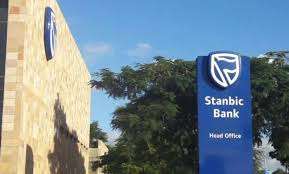
Photo/courtesy.
Stanbic Bank has announced a profit after tax of Sh3.3 Billion for the first quarter ending March, 31st 2025. The Bank has attributed the Q1 performance to a shift in year-on-year macroeconomic dynamics and base effects which have temporarily impacted growth momentum.
The bank said that the Net interest income grew by 5 percent on the back of increased income from customer lending and government securities.
Loan book increased by 6 percent from December 2024, outpacing the private sector credit growth at 0.2 percent, while the deposit book grew by 5 percent from December 2024 signaling customer confidence and greater transactional activity.
Interest expense on customer deposits declined by 25 percent as cost of funding declined in the first quarter of the year, further creating a buffer on the revenue.
Dr. Joshua Oigara, Stanbic Bank Kenya and South Sudan’s Chief Executive, said that the Bank demonstrated resilience amidst a tough operating environment.
“Our Q1 2025 results reflect the dynamic shifts within our operating environment, shaped by both local and global economic headwinds,” Dr. Oigara said.
“We continue to assess these market dynamics and respond appropriately, leveraging our robust strategies and operational flexibility to maintain a strong foundation for future growth. Encouraging signs of continued economic recovery and stability, coupled with a clear strategic roadmap, position us well to navigate the year ahead in delivering long-term, sustainable value for our stakeholders.”
Oigara further said that South Sudan has resumed oil production and exports via Sudan after repairs to the damaged pipeline, a move vital for the country’s financial stability.
“Our South Sudan business continues to demonstrate resilience leveraging the oil ecosystem to support our customer operations.” Dr. Oigara said.
READ: I&M Bank Introduces I&M FX Direct to Power Real-Time Forex Trading
In quarter 1, the Bank continued to focus on customer enablement, as well as cost and risk management which translated to a stronger credit impairment positioning and a low credit loss ratio of 1.19 percent.
Customer numbers went up by 10 percent resulting in higher transaction volumes and increased fee and commission income.
Stanbic’s share price posted a 28 percent year-on-year growth during the period, demonstrating sustained investor confidence and brand trust. The bank noted that Year on Year market capitalization grew by 26 percent to Sh63.9 billion as of March 31st 2025.
Mr. Dennis Musau, Stanbic’s Chief Financial and Value Officer affirmed the Bank’s continued efforts to build innovative solutions for clients, complemented by processes to support client growth.
“Our fundamentals remain resilient with demonstrable growth in core customer segments, a disciplined risk management approach and continued investment in technology and innovation. As we navigate a dynamic operating environment, we stay focused on partnering with our customers, strengthening stakeholder relationships, and delivering sustainable, long-term value,” Musau said.
He further said that their net interest margin increased to 6 percent on optimized costs of funding while their cost to income ratio increases as a result of prior year base effects on expenses which they expect to normalize in the subsequent periods.
“Going forward, we will continue to prioritize balance sheet growth, client experience, operational efficiency and risk management.” Mr. Musau added.
The Bank continued to Stimulate growth in the economy through investment in key growth sectors and market segments.
By the end of March 2025, the Bank had disbursed Sh8.14 billion to SMEs, with Sh1.7 billion channeled to businesses in the Africa China corridor.
The Bank also implemented capacity building and funding programs through the Stanbic Foundation, with over 796 beneficiaries receiving catalytic funding.
Stanbic reduced its base lending rates by 180bps cumulatively in line with the Central Bank of Kenya’s (CBK) drive to spur private sector credit growth in the economy. The Bank’s blended rate has declined by 480bps over the last 6 months.
The Bank was recognized as Winner, Internal Audit Function of the Year in the Banking category at the 2025 Internal Audit and Risk Awards facilitated by the Institute of Internal Auditors (IIA).





